One might think that the recent swell of interest in black art would have eased some of the burdens faced by those who have spent years systematically excluded from major galleries and museums.
Within the past year and a half, Kehinde Wiley and Amy Sherald unveiled the official portraits of Barack and Michelle Obama; Martin Puryear was selected as the second consecutive African American artist to represent the US at the Venice Biennale; Diddy bought a painting by Kerry James Marshall at auction for $21.2 million; and Rashid Johnson’s directorial debut, Native Son, premiered on HBO.
This shift has been greeted by largely celebratory (and sometimes self-congratulatory) coverage. But many black artists say that the paradigm brings unique challenges of its own—and, at the same time, hasn’t corrected for the legacy of racial bias in the mainstream art world.
The nearly dozen black artists I spoke to for this article say that while the industry’s gatekeepers are now paying attention to black culture, establishing strong relationships with them is still disproportionately harder for all artists of color than for their white peers. And if black artists have nabbed a spot, they’ve done it by serving as their own advocates, translators, and promoters in a system not designed to fully understand – or accommodate – blackness.
The challenges begin early. “[Black artists] have to be more careful with their choices than white artists,” says Joeonna Bellorado-Samuels, director at Jack Shainman gallery, a space known for its roster of black artists, “and make sure that the work is presented, articulated, and contextualized in a very specific way.”
With a growing number of established black artists but comparatively fewer curators and gallerists, the task of contextualization often falls on the creators themselves, or is outsourced to a trusted few.
Steffani Jemison, an interdisciplinary artist whose work examines the notion of cultural progress, frequently writes her own press releases because white curators are too afraid to do this themselves, she says. When she’s the only black artist in a show, she adds, she is sometimes treated as a spokesperson for blackness in general and asked to give lectures to broaden the public’s understanding.
(Notably, some black artists declined to be interviewed for this article, explaining that identifying a shared concern among them could cancel out their efforts to put the proper focus on their work.)
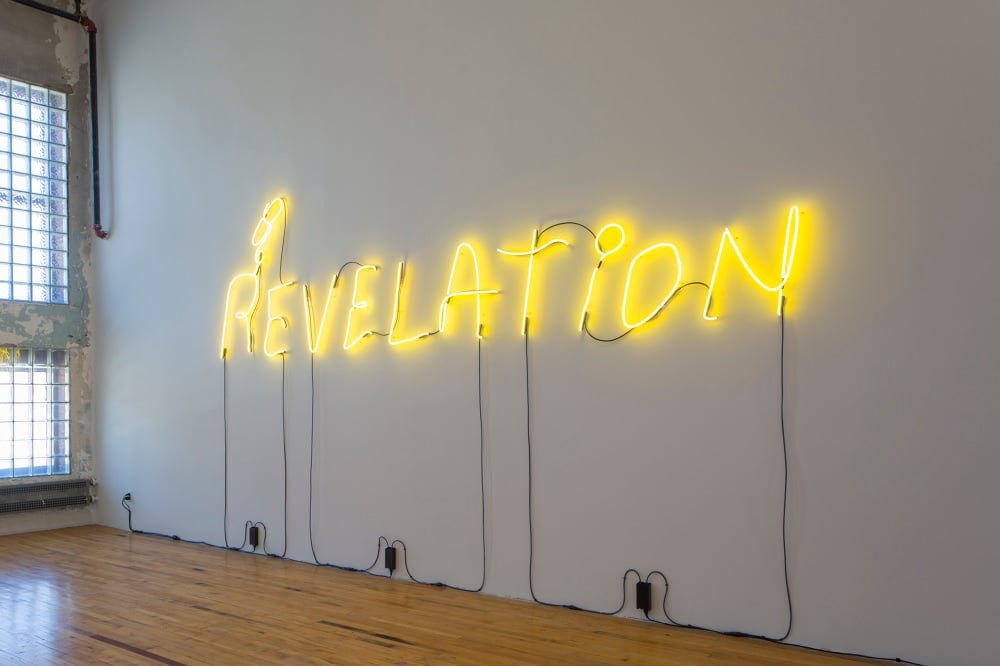
Steffani Jemison, “REVELATiON,” 2017. Photo by David Dashiell, courtesy of MASS MoCA.
Bellorado-Samuels notes that black artists often feel pressure to enter as many spaces as possible (especially ones from which they’ve historically been excluded). Sometimes, the terms of those arrangements can be problematic.
A few years ago, for example, Jemison was included in an exhibition at a coveted New York institution. She was excited—until she found out that the black artists were “ghettoized and put in a separate screening program,” she says, while “very few artists of color were included in the program itself.” Jemison and her cohort felt like add-ons. In order to be taken seriously at these institutions, Jemison has taught herself nearly every element of putting a show together, from planning to education to production.
Artist Sable Elyse Smith, meanwhile, carefully supervises where her work ends up and who she enlists to help translate it. She has ceded some control to her dealer, but still feels the need to remain very hands-on. She reviews drafts of wall texts and press releases. She actively seeks out writers who will meaningfully engage with her work.
These are unpaid tasks in addition to an already punishing schedule. In June at MoMA PS1, she will unveil the work she made during her coveted residency at the Studio Museum in Harlem. That same month, she is part of a group show at the New Museum and her gallery, JTT, will display her work at Art Basel in Switzerland.
Before the end of the year, she’ll be participating in three more group shows – in Philadelphia, Virginia, and Belfast—as well as a solo show at Carlos/Ishikawa in London. And all this is on top of her teaching position at the University of Richmond, not to mention a slate of collaborative projects like contributing to books.
Given these mounting pressures and concerns, it’s not difficult for black artists to experience burnout.Earlier this year, the viral Buzzfeed article “How Millennials Became the Burnout Generation” initiated a discussion about the state of work for this rising generation. Coined by psychologist Herbert Freudenberger in 1974, “burnout” is a state of emotional depletion and cynicism common among professionals with jobs that involve extensive interpersonal engagement. The Buzzfeed article focused on how the social conditions millennials face, coupled with the new economy of creative work and self-branding, has led to a particular kind of exhaustion and ever-present social stress – all very much part of the job for a successful artist.
But burnout isn’t a one-dimensional affliction. The article resonated deeply with a diverse group of people, each citing the distinct challenges that contribute to their burnout. In her response to Buzzfeed’s story, “This Is What Black Burnout Feels Like,” Tiana Clark noted that “no matter the movement or era, being burned out has been the steady state of black people in this country for hundreds of years.” For her part, Jemison cites fellow artist Hito Steyerl in describing burnout as a shared exhaustion, or a “structural condition of generations of black peoples’ experiences.”
As a result, black artists face a double burden of burnout, particularly those walking the high-wire of a rising career in a fickle, slippery market. And there is a history to this sort of pressure. In an article for Artforum in 1993, artist Lorraine O’Grady described meeting the already-wildly celebrated Jean-Michel Basquiat and observing the intense pressure and internal conflict that success produced for him.
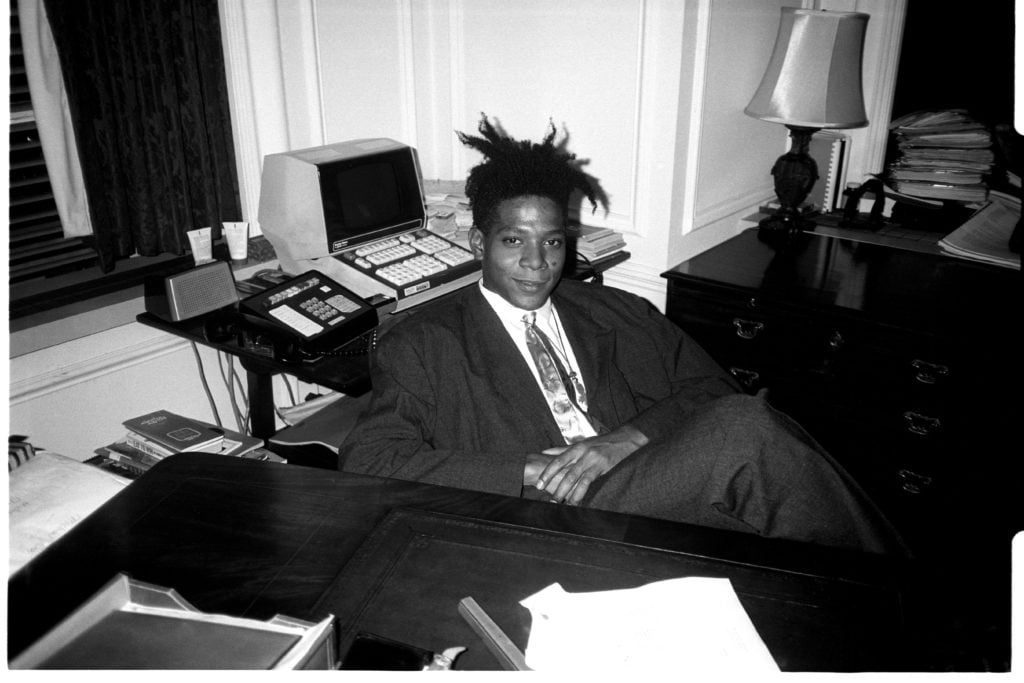
Jean-Michel Basquiat at the surprise birthday party for Susanne Bartsch at the Rainbow Roof, at Steven Greenberg’s office, 30 Rockefeller Plaza. Thursday, September 19, 1985. Photo by Patrick McMullan/Getty Images.
“I’d heard the stories about exploitation… but these were less frightening to me than a white friend’s tale of late-night calls from a Jean-Michel in despair after white patrons had physically recoiled from him. The simplest handshake was a landmine. I knew the artworld was about to eat him up and before it did,” she wrote.
Her essay also illustrates how historically unprecedented his level of acclaim was relative to other black artists. She describes wanting to connect him “to black artists who, picked up in the ’60s and then dropped… had stopped reading art magazines because they knew they would not see themselves there.”
Despite a number of loyal, committed advocates for black art – including many black artists themselves – the art establishment’s “discovery” of the work has been characterized by intense, boom-bust cycles. Today, more black artists are receiving the kind of mainstream attention showered on Basquiat—but many worry about its longevity, particularly in the market, and the pitfalls associated with this newfound spotlight.

Sable Elyse Smith, Installation view, “BOLO: be on (the) lookout” at JTT, New York.
“When artists’ works become market-driven, curators tend to shift their focus, and even the best collectors, who continue to support the output, cannot help but see dollar signs in front of the work,” art advisor Lisa Schiff wrote in a recent op-ed.
Sable Smith manages the potential for exploitation by carefully curating her output. Many others don’t yet have this luxury. “Basquiat is a great example of the tragedy of a black man who was eaten up by the artworld,” says art dealer KJ Freeman, the owner of Housing gallery. “It’s something that’s been replayed over and over again…. And I believe it’s like that because it’s a proven model; if you are the type of guy or you work this type of way, I can definitely make X amount of million dollars on you.”
When examining burnout in young doctors, professor Richard Gunderman noted that “at its deepest level,” burnout was not the result of endless calls on their time. It was, instead, “the sum total of hundreds and thousands of tiny betrayals of purpose,” he wrote, “each one so minute that it hardly attracts notice.”
This sentiment applies to artists, too. The constant pressure to explain and defend their work to a community of people who often misunderstands it can feel like a series of not-so-tiny betrayals – sometimes causing them to second-guess what made them want to be artists in the first place.
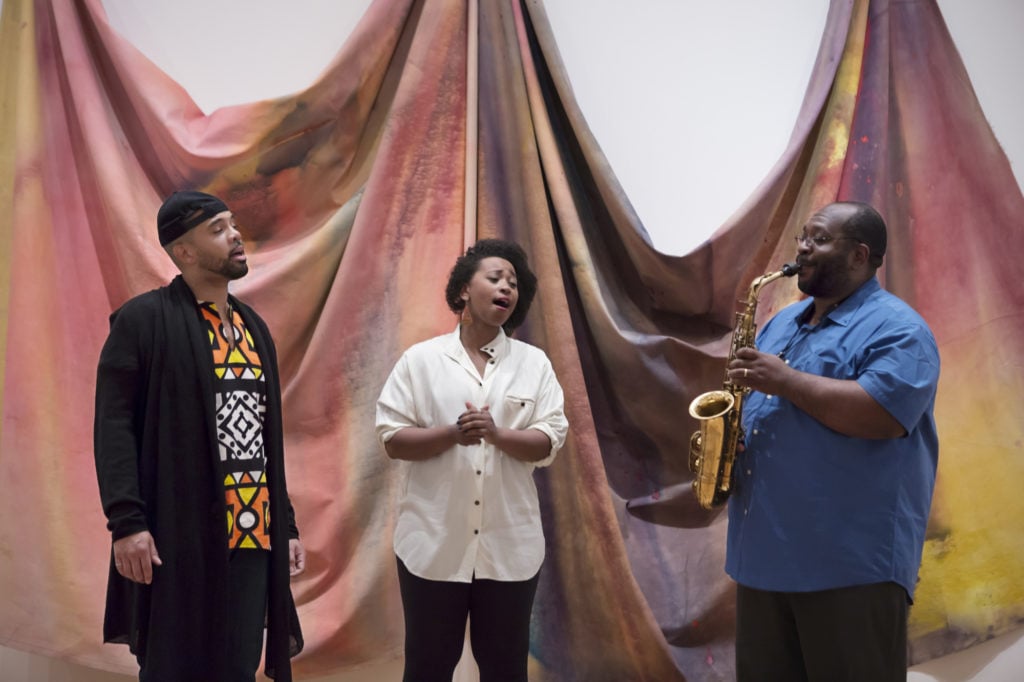
Steffani Jemison, “Promise Machine,” 2015. Courtesy of the artist.
“Navigating the limited existing roles for [black artists] is exhausting, and never-ending,” Jemison says. “And black artists are very aware that being selected is super arbitrary and predicated on partial understanding of the work.”
Kandis Williams, who shows with Night Gallery and whose work reflects on black aesthetic movements, identifies another strain: establishing her voice against a backdrop of problematic black imagery. “We’ve always been consumed, we’ve always been present,” she says of her black community, “but always in spaces of abjection.”
Williams is not alone in feeling conflicted about the type of imagery collectors in particular are gobbling up. “White collectors want to buy representations of a black body,” artist Kayode Ojo says, “and there was a time when you could just buy a black person. It’s like, maybe they’re doing the same thing now.”
Williams ultimately believes that people within the industry tend to reconfigure black images and narratives to align with very narrowly defined notions of race. Struggle narratives have long been particularly palatable to white audiences.
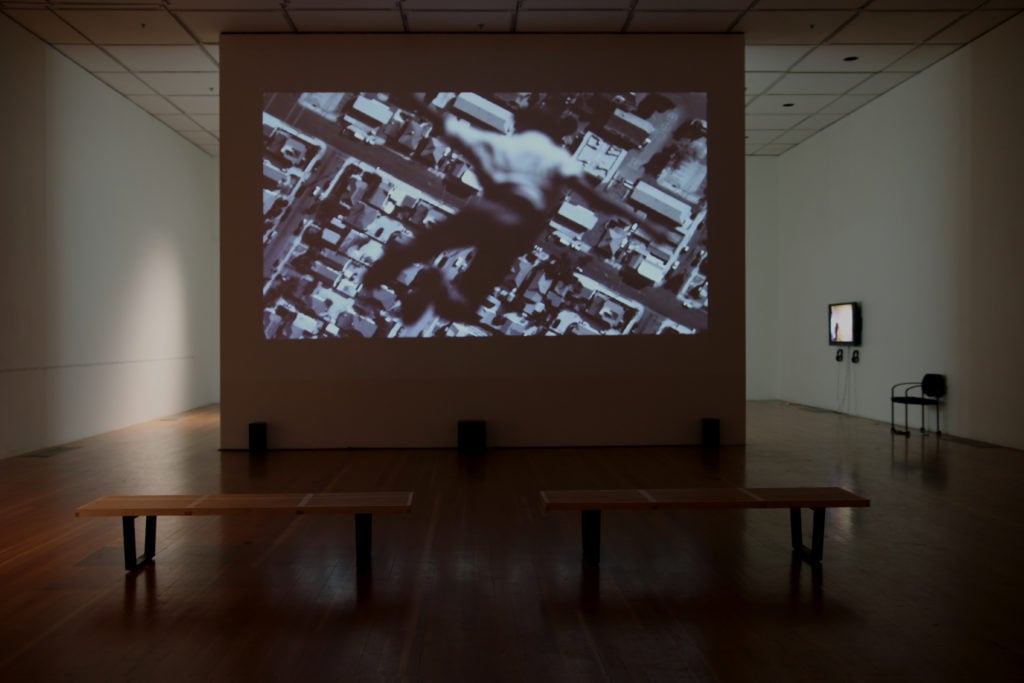
Elyse Sable Smith, “Who Gets To Look” (Installation view), 2017 at UC Irvine Galleries, Irvine, CA.
“In the last three years, there’s been a crazy buzz and excitement around black art, and very specific aspects of black art,” adds Sable Smith, who makes photography, video, text work, and sculpture about trauma, memory, and the carceral state. “There’s been a surge in interest in ‘mass incarceration,’ which is a label that might be superficially placed on my work.”
This subject matter is often conflated with blackness, and she is particularly mindful of the art community exploiting that element of her practice. “Even before I get into the stage of even having an in-depth conversation with some curatorial team,” she says, “you can always kind of read between the lines of what’s missing in email, or what kind of research or investment is even there.”
Some artists say the pressure they feel is shaping the direction they plan to take their careers. Since returning from Art Basel Miami Beach in 2017, Jibade Khalil-Huffman plowed through six solo shows, dotting the country from Florida to California. He feels lucky to have had these opportunities – which materialized because he has developed strong relationships with dealers and curators who are committed to and understand his art – but still recognizes how much extra work he had to do to reach this stage of his career.
At this point, his social anxiety is so severe that he says he doesn’t attend many openings or parties. Social withdrawal aside, the stress of working around the expectations placed on him as a black artist has worn him down. He tries to compensate for networking absences by redoubling his efforts for exposure of his work. He is now seriously considering tapering things off to teach.
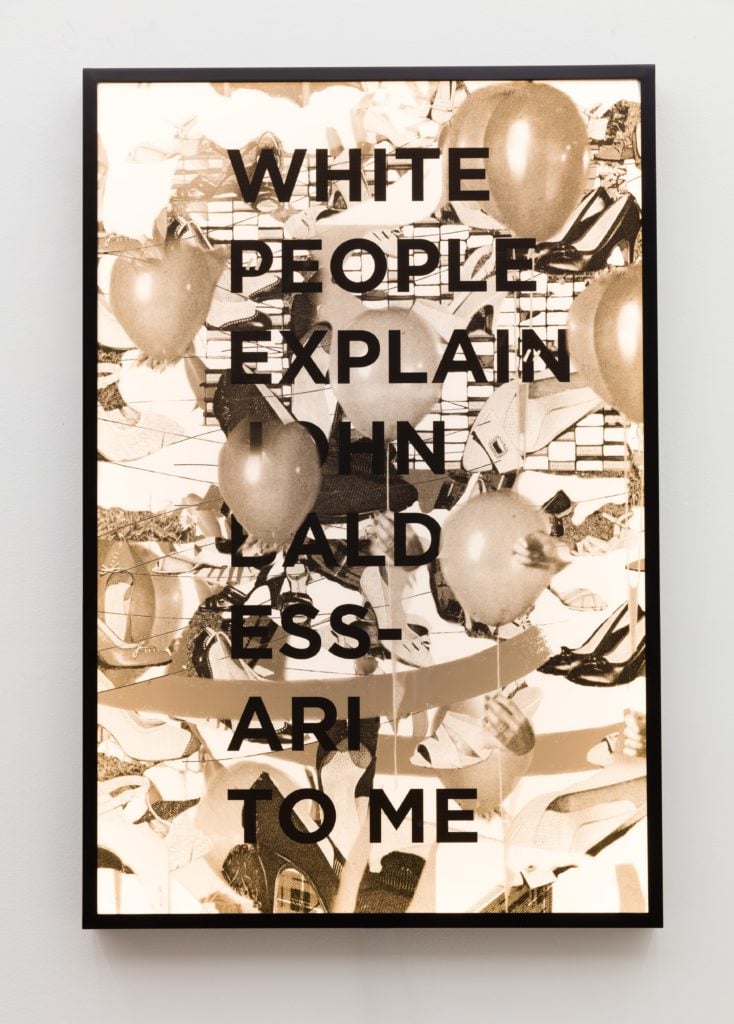
Jibade-Khalil Huffman, “White People Explain John Baldessari To Me,” 2017. Courtesy of Anat Ebgi. Photo by Art Basel.
“Unless [black artists] get into the Studio Museum,” Jemison says, “they continue to be treated like outsiders, and have to rely on insiders to get ahead.”
At the same time, however, a new generation of artists are looking to create a more supportive environment for the next generation to thrive. Sable Smith says she works to “close this deficit for those people who came up like I came up,” she says. Others, including Kehinde Wiley and Titus Kaphar, are also organizing their own residency programs to offer young artists of color a safe space to experiment and develop.
Meanwhile, artist Simone Leigh – who has remarked on the dire cultural conditions black women face, which ultimately threaten their health – has opened self-care centers targeted at minorities to counteract this phenomenon as part of her art practice.
The artworld demands that all artists pay their dues – but black burnout, many artists say, is the result of unfair and unequal distribution of those dues. “I feel obligated to work for change,” Jemison says, “even though [the results of] that work will definitely be beyond the horizon of my own career.”
This article was originally published in artnet News, one of our partners.

















